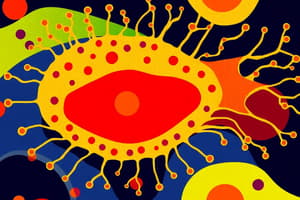Podcast
Questions and Answers
What is the function of the contractile vacuole in Amoeba?
What is the function of the contractile vacuole in Amoeba?
- Breaks down bacteria for energy production
- Aids in the movement of the pseudopodia
- Eliminates excess water and expels it from the cell (correct)
- Stores excess water for future use
Where is the ectoplasm located in an Amoeba cell?
Where is the ectoplasm located in an Amoeba cell?
- Surrounds the contractile vacuole
- Fills the rest of the cell
- Just inside the cell membrane (correct)
- Forms the pseudopodia
What is the role of endoplasm in an Amoeba cell?
What is the role of endoplasm in an Amoeba cell?
- It eliminates excess water from the cell
- It is involved in movement and houses cell organelles (correct)
- It stores food for the cell
- It aids in the production of energy
How does chemotaxis influence the movement of Amoeba?
How does chemotaxis influence the movement of Amoeba?
What causes the movement of Amoeba in a specific direction?
What causes the movement of Amoeba in a specific direction?
How is feeding in Amoeba primarily carried out?
How is feeding in Amoeba primarily carried out?
What happens to undigested food in Amoeba?
What happens to undigested food in Amoeba?
How does reproduction occur in Amoeba?
How does reproduction occur in Amoeba?
What is the role of lysosomes in the feeding process of Amoeba?
What is the role of lysosomes in the feeding process of Amoeba?
What happens when Amoeba reaches a certain size during reproduction?
What happens when Amoeba reaches a certain size during reproduction?
Flashcards are hidden until you start studying
Study Notes
Contractile Vacuole Functions
- Regulates osmotic pressure by expelling excess water from the cell.
- Maintains internal fluid balance, preventing swelling or bursting of the cell.
Ectoplasm Location
- Ectoplasm is found just beneath the cell membrane, surrounding the endoplasm.
- Responsible for maintaining cellular shape and structure.
Role of Endoplasm
- Contains organelles and is the site for metabolic activities.
- Facilitates movement and locomotion through pseudopodia formation.
Chemotaxis Influence
- Chemotaxis allows Amoeba to move toward or away from chemical stimuli in the environment.
- Positive chemotaxis leads Amoeba toward nutrients, while negative chemotaxis directs it away from harmful substances.
Directional Movement
- Movement in a specific direction is influenced by gradients of chemicals in the surroundings.
- Pseudopodia extend and retract toward favorable conditions or food sources.
Feeding Process
- Feeding is primarily conducted through phagocytosis, where Amoeba engulfs food particles.
- The organism surrounds food with pseudopodia, forming a food vacuole.
Undigested Food
- Undigested food remains inside the vacuole until it is expelled from the cell.
- Excretion of waste occurs through the cell membrane once digestion is complete.
Reproduction
- Amoeba reproduces asexually through binary fission.
- The cell divides into two genetically identical daughter cells.
Lysosomes' Role in Feeding
- Lysosomes contain digestive enzymes that break down engulfed food within food vacuoles.
- They convert complex molecules into simpler forms that can be absorbed by the cell.
Size and Reproduction
- When reaching a certain size, Amoeba prepares for binary fission.
- Growth triggers internal processes that lead to cell division.
Studying That Suits You
Use AI to generate personalized quizzes and flashcards to suit your learning preferences.




